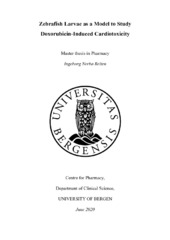Zebrafish Larvae as a Model to Study Doxorubicin-Induced Cardiotoxicity
Master thesis
Permanent lenke
https://hdl.handle.net/1956/23134Utgivelsesdato
2020-06-30Metadata
Vis full innførselSamlinger
- Master theses [30]
Sammendrag
Doxorubicin is one of the most versatile cytostatic drugs available and shows efficacy on most cancer forms. However, it also possesses the risk of cardiotoxicity that is hard to predict, can occur decades after treatment, and that limits the cumulative lifetime doses of the drug. Various approaches have been tested to avoid this toxicity, with liposomal forms of doxorubicin already being on the market. Additionally, some studies have shown that statins can limit doxorubicin induced cardiotoxicity, and also improve the anti-cancer effects of the drug. The zebrafish has over the last decades emerged as a convenient and relevant model for human cancer research. The species has rapid development, the skin is optically transparent, their genome is comparable to that of humans, and they enable for very easy in vivo imaging. In this study zebrafish larvae were used to study the potential cardioprotective effect of simvastatin in co-treatment with doxorubicin, as well as how liposomal formulations of these drugs influence heart function. Moreover, the zebrafish larvae were tested as a model organism for cancer. Doxorubicin was loaded into liposomes with or without simvastatin incorporated into the lipid bilayer and tested in in vitro cytotoxicity assays on H9C2 cardiomyoblast cells and MCF-7 breast cancer cells and in vivo in zebrafish larvae. Additionally, fluorescently stained MCF-7 cells were injected in zebrafish larvae and observed over two days. In the zebrafish larvae injected with fluorescent MCF-7 cells in the yolk sac, the fluorescent signal was observed to spread to the tail of the zebrafish larvae after one- and two-days post injection and to increase in number and size. More experiments need to be conducted to verify this being viable MCF-7 cells. Liposomal forms of doxorubicin were found to have less impact on zebrafish heart rate, death and pericardial edema and resulted in increased viability in the cytotoxicity assays compared to free doxorubicin. Co-loading with simvastatin did not give an observed additional cardioprotective effect in zebrafish larvae. In the in vitro studies, however, free simvastatin co-therapy with high-doses of free doxorubicin contributed to increased viability of H9C2 cardiomyoblast cells relative to free doxorubicin alone, while no such effect was observed for the MCF-7 breast cancer cells. The zebrafish larvae allow for direct observations of physiological functions in an intact, living organism, while still being an inexpensive model. Therefore, zebrafish larvae prove superior to cell cytotoxicity models in the study of toxicity and efficacy of anti-cancer drugs.
